The Intel Comet Lake Core i9-10900K, i7-10700K, i5-10600K CPU Review: Skylake We Go Again
by Dr. Ian Cutress on May 20, 2020 9:00 AM EST- Posted in
- CPUs
- Intel
- Skylake
- 14nm
- Z490
- 10th Gen Core
- Comet Lake
Our Office and Science Test section focuses significantly on real-world testing, user experience, with a slight nod to throughput. In this section we cover application loading time, image processing, simple scientific physics, artificial intelligence, and AVX accelerated code.
All of our benchmark results can also be found in our benchmark engine, Bench.
Office Tests
Application Load: GIMP 2.10.4
One of the most important aspects about user experience and workflow is how fast does a system respond. A good test of this is to see how long it takes for an application to load. Most applications these days, when on an SSD, load fairly instantly, however some office tools require asset pre-loading before being available. Most operating systems employ caching as well, so when certain software is loaded repeatedly (web browser, office tools), then can be initialized much quicker.
In our last suite, we tested how long it took to load a large PDF in Adobe Acrobat. Unfortunately this test was a nightmare to program for, and didn’t transfer over to Win10 RS3 easily. In the meantime we discovered an application that can automate this test, and we put it up against GIMP, a popular free open-source online photo editing tool, and the major alternative to Adobe Photoshop. We set it to load a large 50MB design template, and perform the load 10 times with 10 seconds in-between each. Due to caching, the first 3-5 results are often slower than the rest, and time to cache can be inconsistent, we take the average of the last five results to show CPU processing on cached loading.
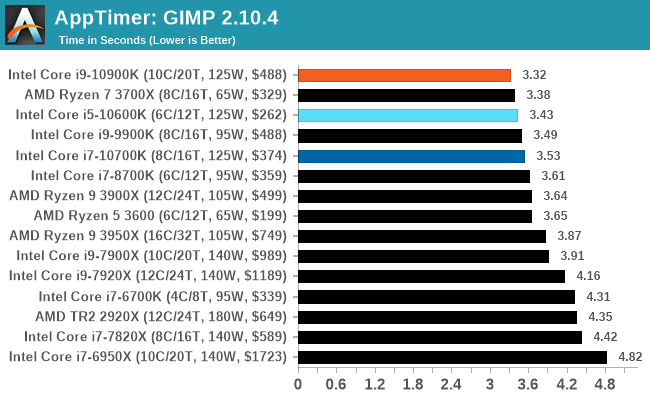
GIMP likes fast single core performance, and so the Core i9 wins here.
Agisoft Photoscan 1.3.3: 2D Image to 3D Model Conversion
One of the ISVs that we have worked with for a number of years is Agisoft, who develop software called PhotoScan that transforms a number of 2D images into a 3D model. This is an important tool in model development and archiving, and relies on a number of single threaded and multi-threaded algorithms to go from one side of the computation to the other.
In our test, we take v1.3.3 of the software with a good sized data set of 84 x 18 megapixel photos and push it through a reasonably fast variant of the algorithms, but is still more stringent than our 2017 test. We report the total time to complete the process.
Agisoft’s Photoscan website can be found here: http://www.agisoft.com/

Agisoft is a mix of variable threaded workloads, so a good balanced system works best. Intel's $500 option is faster than AMD's $500 option here, with two fewer cores.
AI Benchmark
One of the longest time requests we’ve had for our benchmark suite is AI-related benchmark, and the folks over at ETH have moved their popular AI Benchmark from mobile over PC. Using Intel’s MKL and Tensorflow 2.1.0, we use version 0.1.2 of the benchmark which tests both training and inference over a variety of different models. You can read the full scope of the benchmark here.
This is one of our new tests in the database, and we are still gaining data for it.
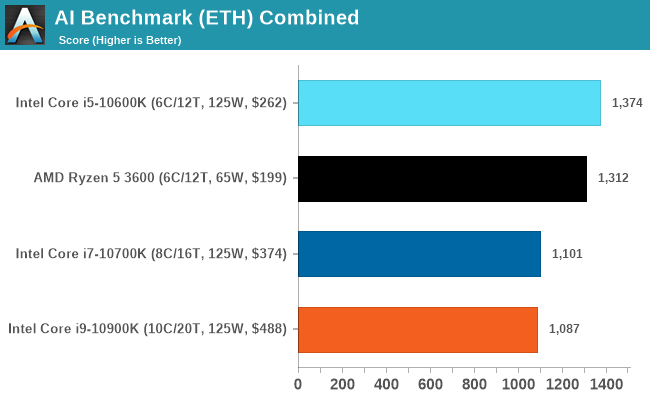
AIBench is a new test here, covering both training and inference. In the breakdown of results, we noticed that the faster processors were actually slower, scoring a lower result. We believe this is down to the lower bandwidth/core afforded by the 10c design against the 6c design.
Accelerated Science Tests
3D Particle Movement v2.1: Brownian Motion
Our 3DPM test is a custom built benchmark designed to simulate six different particle movement algorithms of points in a 3D space. The algorithms were developed as part of my PhD., and while ultimately perform best on a GPU, provide a good idea on how instruction streams are interpreted by different microarchitectures.
A key part of the algorithms is the random number generation – we use relatively fast generation which ends up implementing dependency chains in the code. The upgrade over the naïve first version of this code solved for false sharing in the caches, a major bottleneck. We are also looking at AVX2 and AVX512 versions of this benchmark for future reviews.
For this test, we run a stock particle set over the six algorithms for 20 seconds apiece, with 10 second pauses, and report the total rate of particle movement, in millions of operations (movements) per second. We have a non-AVX version and an AVX version, with the latter implementing AVX512 and AVX2 where possible.
3DPM v2.1 can be downloaded from our server: 3DPMv2.1.rar (13.0 MB)
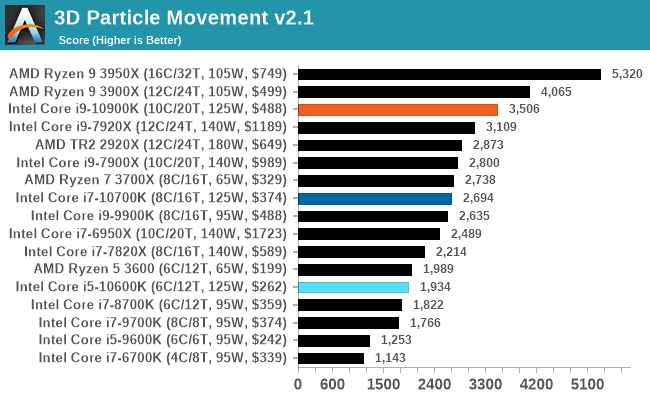
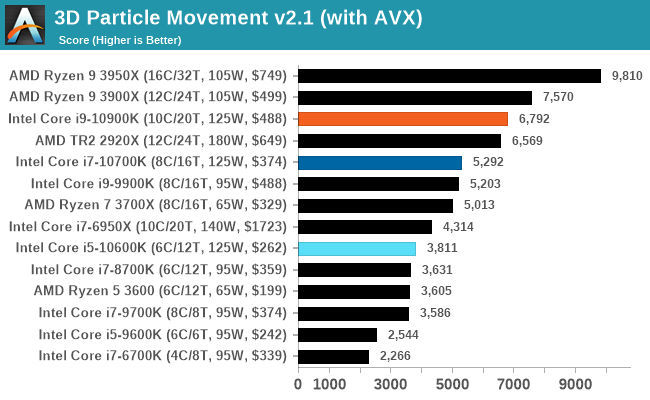
No real surprises in our 3DPM tests.
y-Cruncher v0.7.6: Microarchitecture Optimized Compute
I’ve known about y-Cruncher for a while, as a tool to help compute various mathematical constants, but it wasn’t until I began talking with its developer, Alex Yee, a researcher from NWU and now software optimization developer, that I realized that he has optimized the software like crazy to get the best performance. Naturally, any simulation that can take 20+ days can benefit from a 1% performance increase! Alex started y-cruncher as a high-school project, but it is now at a state where Alex is keeping it up to date to take advantage of the latest instruction sets before they are even made available in hardware.
For our test we run y-cruncher v0.7.6 through all the different optimized variants of the binary, single threaded and multi-threaded, including the AVX-512 optimized binaries. The test is to calculate 250m digits of Pi, and we use the single threaded and multi-threaded versions of this test.
Users can download y-cruncher from Alex’s website: http://www.numberworld.org/y-cruncher/
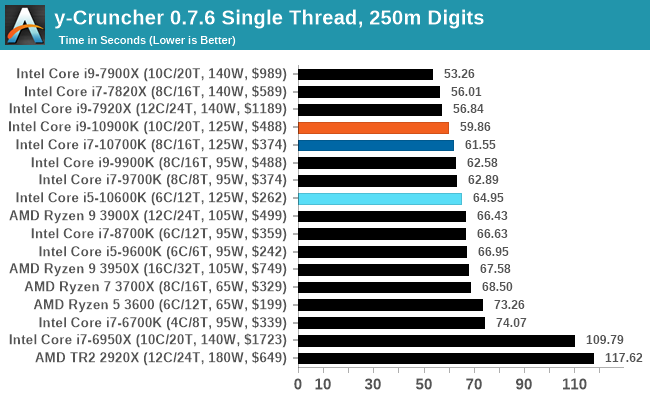
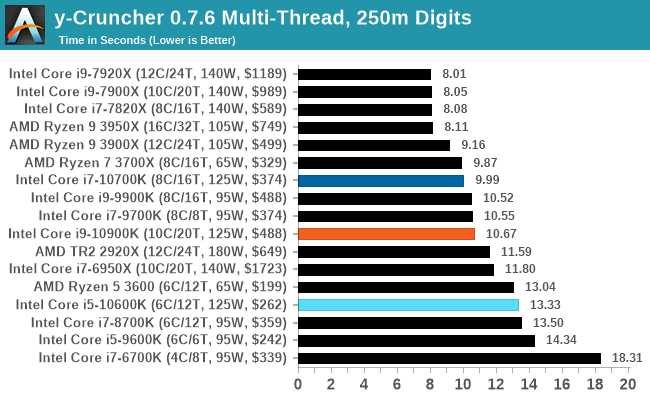
y-Cruncher is another one where the Core i9 performs worse than the Core i7 in the multithreaded test, despite being better on the single threaded test. We again put this down to memory bandwidth. We need to update this test to the latest version of y-Cruncher, which has additional optimizations for Zen 2 processors, but also to increase the digit count in our MT test.


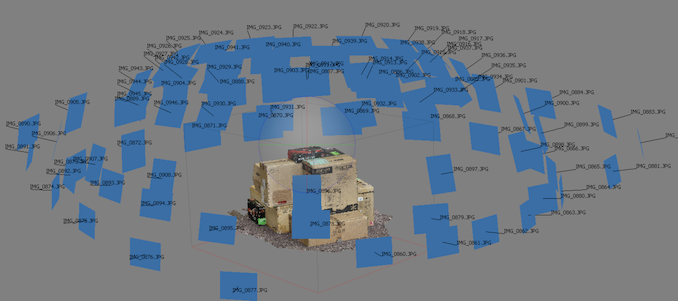








220 Comments
View All Comments
Darkworld - Wednesday, May 20, 2020 - link
10500k?Chaitanya - Wednesday, May 20, 2020 - link
Pointless given R5 3000 family of CPUs.yeeeeman - Wednesday, May 20, 2020 - link
Yeah right. Except it will beat basically all and lineup in games. Otherwise it is pointless.yeeeeman - Wednesday, May 20, 2020 - link
All AMD lineup*SKiT_R31 - Wednesday, May 20, 2020 - link
Yeah with a 2080 Ti the flagship 10 series CPU beats AMD in most titles, generally by a single digit margin. Who is pairing a mid-low end CPU with such a GPU? Also if there were to be a 10500K, you probably don't need to look much further than the 9600K in the charts above.This may have been missed on you, but what CPU reviews like the above show is: unless you are running the most top end flagship GPU and are low resolution high fps gaming, AMD is better at every single price point. Just accept it, and move on.
Drkrieger01 - Wednesday, May 20, 2020 - link
It also means that if you have purchased an Intel 6th gen CPU in i5 or i7, there's not much reason to upgrade unless you need more threads. And it will only be faster if you're using those said threads effectively. I'm still running an i5 6600K, granted it's running at 4.6GHz - there's no reason for me to upgrade until either Intel and/or AMD come up with better architecture and frequency combination (IPC + clock speed).I'll likely be taking the jump back to AMD for the Ryzen 4000's after a long run since the Sandy Bridge era.
Anyone needing only 4-6 cores should wait until then as well.
Samus - Thursday, May 21, 2020 - link
That's most people, including me. I'm still riding my Haswell 4C/8T because for my applications the only thing more cores will get me is faster unraring of my porn.Lord of the Bored - Thursday, May 21, 2020 - link
Hey, that's an important task!Hxx - Wednesday, May 20, 2020 - link
at 1440p intel still leads in gaming. It may not lead by much or may not lead by enough to warranty buying it over Intel but the person buying this chip is rocking a high end gpu and will likely upgrade to a high end gpu and the performance gap will only widen in intel's favor as the gpu becomes less of a bottleneck. So yeah pairing this with a 2060 makes no sense, go AMD. but pairing this with a 2080ti and a soon to be released 3080TI oh yeah this lineup will be a better choice.DrKlahn - Thursday, May 21, 2020 - link
By that logic the new games released since the Ryzen 3x000 series debut last year should show a larger gap at 1440+ between Intel and AMD. But they don't. And judging by past trends I doubt they will in the future either.As GPUs advance so does the eye candy in the newer engines, keeping the bottleneck pretty much where it always is at higher resolutions and detail levels, the GPU.